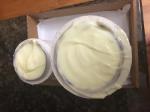Canola Oil for Soap Making
Canola Oil is a wonderfully inexpensive option when it comes to soap making ingredients.
Not only does it contain Vitamin E, an anti-oxidant that will help to protect your skin from free radicals, it also contains omega 3 and omega 6 fatty acids which help to combat premature ageing and soothe dry, irritated skin.
Some of the links on this site are affiliate links. If you buy a product through them, I receive a small commission which helps me provide the free information you find on this site. Thank you for your support!
The name "Canola" was originally derived from the phrase "Canadian oil, low acid" and is now considered a North American cash crop though the European Union produces it's fair share.
Unfortunately, this oil has been the victim of a few myths. Here are a couple of facts about this oil.
It is NOT the same as rapeseed oil though the plants do look the same and are related. The canola plant was cultivated using traditional methods to remove the "bad stuff", specifically, elucidate acid and glucosinolates.
Though much of our Canola Oil does come from genetically modified plants, the final oil does not contain any GMO material. The modification has been made to one protein gene that is removed during the process of turning the plant into an oil.
In addition, an organic version of the oil is available which does not come from GMO seeds.
The refined oil is quite long lasting with a high heat tolerance and will last up to a year if stored properly, much like most vegetable oils.
Common Name: Canola Oil
Botanical Name: Brassica Campestris
INCI Name: Canola Oil
Common Extraction Method: Pressed from the seeds of the plant and refined.
Plant Origin: North American and the European Union
Physical Description: A very pale, clear liquid that absorbs easily.
Aromatic Description: Has very little in the way of scent.
Approximate SAP Value: KOH - 186; NaOH - 133
Soap Making Characteristics: Canola Oil makes a great addition to your soap making oil collection. Aside from the obvious plus of being super inexpensive, it also produces a soap with a lovely dense, creamy lather.
It's light colour is very helpful when attempting to produce a white soap and it is slow to trace making it a good choice when using techniques like swirling.
You can replace up to 40% of the liquid oils in a recipe with Canola Oil though I prefer to keep it around the 20% range.
Cautions: None Known
Recipe Suggestions: Try replacing a portion of olive oil in any recipe from the Homemade Soap Recipes page or the Palm Free Soap Recipes page with this oil. (Don't forget that any time you change a soap making recipe, you need to run the recipe through a lye calculator in order to get the new correct lye amount.)
Fatty Acid Content: The chart below shows the approximate percentages of fatty acids present in this oil.
| Lauric | Myristic | Palmitic | Stearic | Ricinoleic | Oleic | Linoleic | Linolenic |
| 4 | 2 | 61 | 21 | 9 | |||
| Hardness | |||||||
| Cleansing | |||||||
| Full Lather | F/L | ||||||
| Stable Lather | |||||||
| Conditioning | |||||||
This information is provided for reference use only and is not meant to substitute the advice of a licensed health care professional.


Facebook Comments